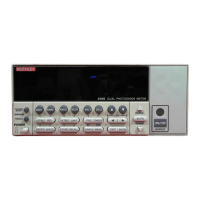Models 2500 and 2502 User’s Manual Limit Testing 11-11
SOT line
The input line (SOT) of the Digital I/O is used to control the start of the testing process.
When ↓STEST is the selected arm event of the trigger model, the testing process will start
when the SOT line is pulsed low. When ↑STEST is the selected arm event, the testing pro-
cess will start when the SOT line is pulsed high. When ↑↓STEST is the selected arm
event, the testing process will start when the SOT line is pulsed either high or low. With
the IMMEDIATE arm event selected, the testing process will start as soon as the LIMIT
key is pressed (assuming the output is ON). See Section 10 for details on trigger model
configuration.
When using the SOT line, the handler will not pulse the line while it is in a not ready con-
dition. When the handler is ready (DUT properly positioned in the handler), it pulses the
SOT line low or high to start the test.
/OE line
The /OE (output enable) line of the Digital I/O can be used if the component handler is
equipped with an interlock switch. With proper use of output enable, power is removed
from the DUT when the lid of the handler is opened. See Section 12, “Digital I/O port”
and “Output enable,” for operation details on the interlock.
Handler types
The Model 2500 can be used with either of the two basic types of handlers. When used
with a Category Pulse Handler, the Model 2500 pulses one of the four handler lines. The
handler then places the DUT into the bin assigned to the pulsed line.
When used with a Category Register Handler, the Model 2500 outputs a bit pattern to
three handler lines. After the Model 2500 sends the end-of-test (EOT) strobe pulse to the
fourth handler line, the handler places the DUT into the bin assigned to that bit pattern.
Category pulse component handler
When using this type of handler, the Model 2500 pulses one of the four handler lines when
a pass or fail condition occurs. The handler then places the DUT in the bin assigned to that
pulsed line. When interfacing to this type of handler, a maximum of four component han-
dler bins are supported.
If the handler requires low-going pulses, then the four digital output lines of the Model
2500 must initially be set to high. This initial HI, HI, HI, HI clear pattern on the output
lines represents a no action condition for the handler since it is waiting for one of the lines
to go low. A line goes low when the defined fail or pass pattern sets it low. For example, if
you want a particular test failure to pulse line #4 of the handler, the defined fail pattern has
to be HI, HI, HI, LO. When the failure occurs, line #4 will be pulled low, and the DUT will
be placed in the bin assigned to that pulsed line.
Test Equipment Depot - 800.517.8431 - 99 Washington Street Melrose, MA 02176
TestEquipmentDepot.com

